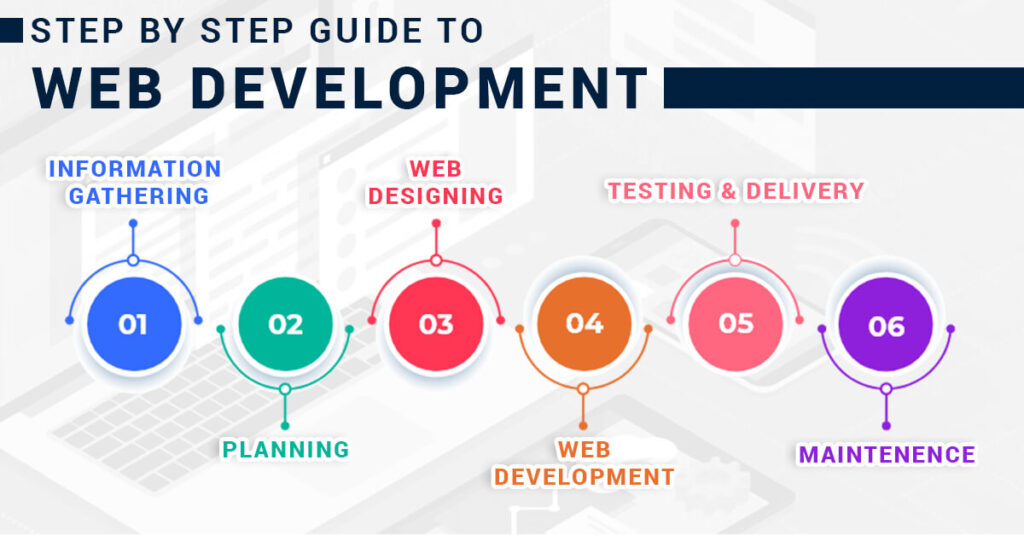In the digital age, having a well-designed and functional website is crucial for businesses, entrepreneurs, and individuals looking to establish a strong online presence. Website development involves various stages, from planning and design to coding, deployment, and maintenance. This guide will walk you through the essential steps to create a professional website that stands out.

1. Understanding Website Development
Website development refers to the process of building and maintaining a website. It consists of two primary aspects:
Front-End Development: Focuses on the user interface (UI) and user experience (UX) using HTML, CSS, and JavaScript.
Back-End Development: Handles database management, authentication, and server-side functionality using languages such as Python, PHP, Node.js, and Ruby on Rails.
Additionally, website development includes web design, content creation, SEO optimization, and website performance improvements.
2. Planning Your Website
Before diving into development, proper planning is essential. Consider these key factors:
Define the Purpose: Is your website for a business, an e-commerce store, a personal portfolio, or a blog?
Identify Your Target Audience: Understanding your audience helps in designing a user-friendly experience.
Determine Key Features: Common features include contact forms, payment gateways, live chat, and search functionality.
Choose the Right Platform: Depending on your needs, you can opt for a CMS (e.g., WordPress, Shopify, Wix) or build a custom-coded site.
Creating a sitemap and wireframe can help visualize the structure and flow of your website before development begins.
3. Choosing the Right Tech Stack
The choice of technologies depends on your website’s complexity and functionality. Commonly used technologies include:
Front-End Development:
HTML, CSS, JavaScript (React, Angular, Vue.js)
Back-End Development:
Node.js, Python (Django, Flask), PHP (Laravel), Ruby on Rails
Database Management:
MySQL, PostgreSQL, MongoDB, Firebase
Web Hosting & Deployment:
AWS, DigitalOcean, Vercel, Netlify
CMS (for easier management):
WordPress, Webflow, Shopify, Joomla
4. Designing the Website
A well-designed website improves user experience and boosts engagement. Key design principles include:
Mobile-First Design: Ensure your site is responsive on all devices.
Clear Navigation: Users should easily find what they need.
Brand Consistency: Use uniform colors, fonts, and layouts.
Fast Loading Speed: Optimize images and scripts to enhance performance.
SEO Optimization: Implement SEO-friendly URLs, meta descriptions, and structured data.
Using design tools like Figma, Adobe XD, or Sketch can help create visually appealing website prototypes.
5. Developing and Testing Your Website
Once the design is finalized, development begins:
Front-End Development: Convert designs into interactive web pages.
Back-End Development: Set up servers, databases, and authentication systems.
Integration: Connect APIs for payments, live chat, or third-party services.
Testing: Conduct usability, performance, and security tests before deployment.
Popular testing tools include Selenium, Jest, and Google Lighthouse for performance auditing.
6. Deploying and Maintaining Your Website
After testing, the website is ready for launch. Follow these steps:
Select a Hosting Provider: Bluehost, AWS, GoDaddy, or Cloudflare.
Register a Domain Name: Choose a unique and memorable domain.
Optimize for SEO: Implement on-page and off-page SEO strategies.
Regular Updates: Keep software, plugins, and content up to date.
Monitor Performance: Use tools like Google Analytics and Search Console to track user engagement and troubleshoot issues.
7. Keeping Up with Web Development Trends
The web development landscape is constantly evolving. Staying updated with the latest trends can give your website a competitive edge:
Progressive Web Apps (PWAs): Enhance speed and offline accessibility.
AI and Chatbots: Improve customer interactions and automation.
Voice Search Optimization: Cater to voice assistant users.
Dark Mode and Minimalist UI: Provide a modern and user-friendly experience.
Cybersecurity Enhancements: Protect against data breaches and hacking attempts.
Conclusion
Website development is a dynamic and continuous process that requires careful planning, technical expertise, and regular maintenance. Whether you’re a beginner or an experienced developer, following best practices and staying updated with industry trends will help you create a successful, high-performing website.

